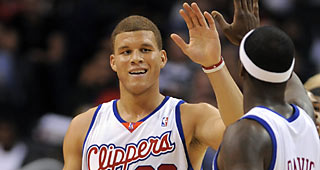One of the elements opposing teams emphasize when they game plan for the Clippers is to collapse into the paint and also to be aggressive in preventing dunks and layups by committing fouls.
The Clippers rank 15th in total field goal percentage (45.6%), but are 28th in three-point shooting (33.3%) and 30th in free throw shooting (68.5%).
Because of these factors, the Clippers are ranked an underachieving 22nd in points scored per 100 possessions at 104.8.
The Clippers average 26.7 free throws per game, which places them fifth in the NBA.
Beyond the simple arithmetic of promising scoring opportunities put on uncertain ice at the line, dribble penetration is met with massive congestion and creates lower percentage shots.
Even though he has yet to develop into a pure post player, Blake Griffin constantly faces a collapsed defense when he receives the ball in the block since opposing teams are committed to stopping him. He can't go to work unimpeded and he also takes a physical beating that undoubtedly causes wear and tear in an immeasurable way both in the short and long term. Griffin says he prefers a physical game, but he is also enjoys those opportunities to fly through the air unimpeded.
Current Offensive Strengths
Speed and Athleticism in Transition
With Griffin's speed and elevation, the Clippers' first option offensively is always to find him on alley-oops in fastbreaks and early offense. He is such a rare talent in this regard and the degree of difficult of his conversions is at least half of what makes him so remarkable.
The freedom from Mike Dunleavy, who was always far too active in calling plays from the sidelines, clearly helps the Clippers here.
Baron Davis can play a more fluid game and help facilitate for Griffin, while the offense frequently goes inside/outside to find Eric Gordon.
Current Offensive Weaknesses
Halfcourt Scoring
The Clippers struggle to score late in the game when things slow down and they are forced to play halfcourt basketball.
Good teams in the halfcourt typically will rely on a great ISO scorer, or the pick-and-roll.
The Clippers certainly don't have the former and they are weak in the latter.
This is something Davis stressed following their 105-91 win over Golden State on Sunday, talking about the importance of 'managing leads'.
During the previous Sunday, the Clippers had an 11-point halftime lead but were outscored by 20 points in the second half when the game became slower.
Personnel to Add
More Shooters
Gordon is nearly a 37% career three-point shooter, but he is hitting a more modest 32.6% of his attempts this season. He has evolved into more of a lead scorer for the Clippers and opposing defenses focus more of their defensive attention towards him, limiting his number of open looks. Gordon is averaging 6.6 more points per 36 minutes this season than he did as an NBA sophomore and he is seeing opponents remain close to him at all times to force him into situations where he will need to put the ball on the deck in order to score.
Al-Farouq Aminu is hitting more than 40% of his three-point attempts this season, but he profiles as a slasher and fairly mediocre perimeter shooter over the longterm.
Ryan Gomes, the Clippers' starter at small forward, is averaging a respectable 35.9% from distance. He'll hit a good percentage of his open looks and gets a lot of him since he isn't a frequent scorer.
Pick-and-Roll Partner for Griffin
Shawn Kemp, the player I most closely associate with Griffin in terms of a big flying through the air, had Gary Payton during the first stretch of his career.
Amar'e Stoudemire had Stephon Marbury during his first two seasons, Steve Nash after that and Raymond Felton now that he is with the Knicks.
Baron Davis is the incumbent and still an extremely gifted and creative passer, but he is scoring just 9.6 points per game and 13.1 points per 36 minutes, both of which are easily his lowest outputs since his rookie season.
Because Davis isn't the same scorer he once was and remains a streaky, low-percentage perimeter shooter, defenders will go underneath on the pick-and-roll and clog the lane to defend against Griffin.
Griffin also has a long ways to go become a threat with the pick-and-pop, even though that is one area he is clearly emphasizing in his development.
The Clippers don't have any sure things to develop with Griffin.
Randy Foye is simply an undersized shooting guard and won't be around past his current contract, which expires in 2012.
Eric Bledsoe has the physical gifts to evolve into this type of player, but he is far too inexperienced to really know what the Clippers have in him at this point. He has promising court vision, speed and athleticism off the dribble and also has the ability to be a good jump shooter. He is receiving significant minutes as Vinny Del Negro has tried to preserve Davis, though he is playing less than he did during the first few weeks of the season.
• The Clippers can always look to trade Chris Kaman, but they are more likely to acquire one of the two above players from the draft.
Their own 2011 first rounder will be at least a lottery selection, but the 2012 draft will be fascinating for the Clippers since they will own Minnesota's outright. The 2012 draft should be much stronger than 2011 because labor uncertainty should be resolved by then and there is little chance for the Wolves to be out of the league's bottom 20% by then.
 RealGM Analysis
RealGM Analysis
How To Improve The Clippers Offense



